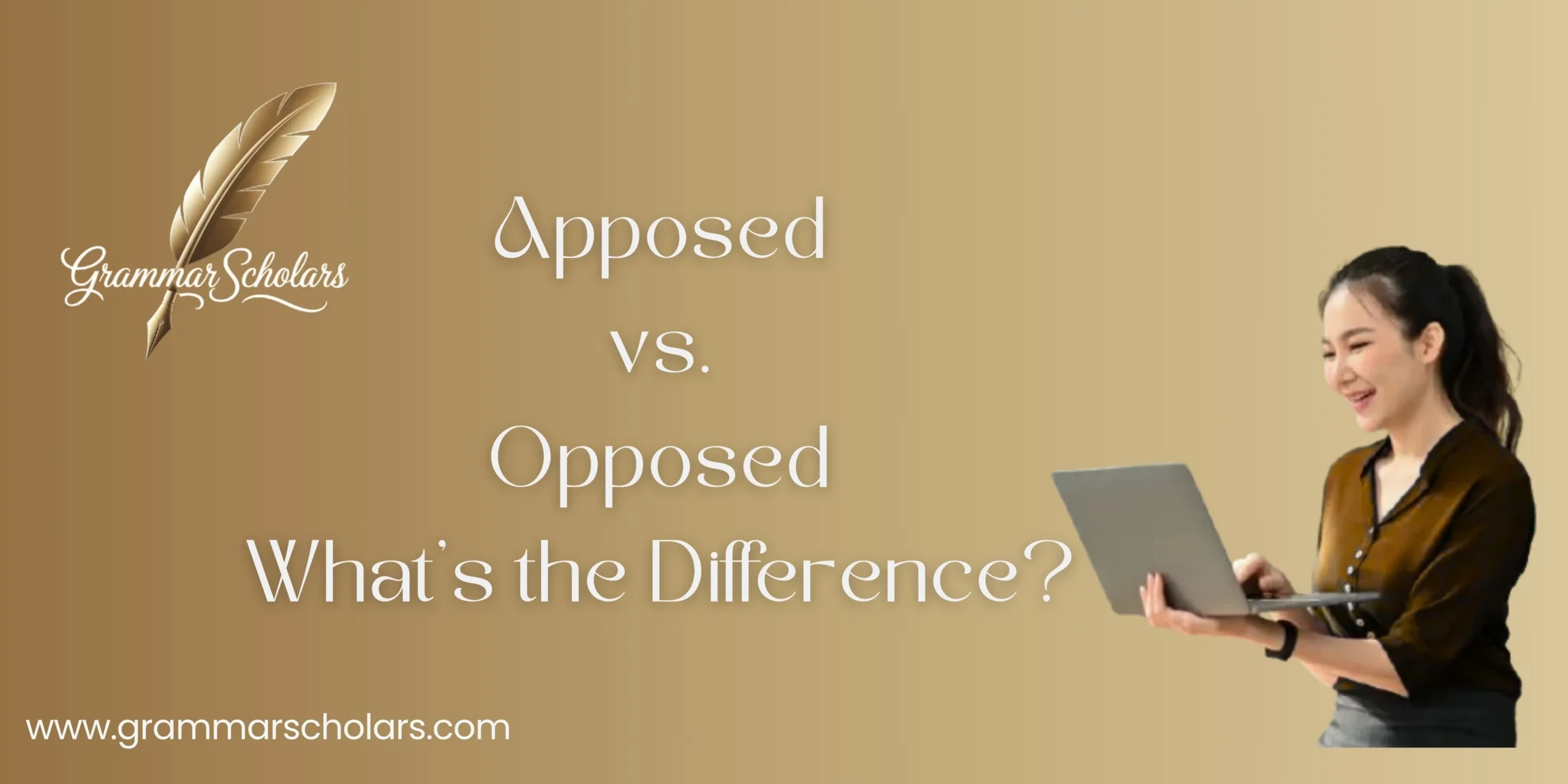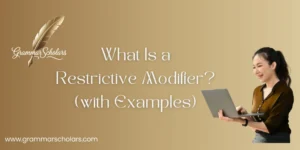While learning English, many mix up apposed vs. opposed as they sound alike, but one relates to placement and the other to resistance. This guide on Apposed vs. Opposed – What’s the Difference? Explains their distinct uses so you avoid errors while writing.
Words can sound almost identical but carry entirely different meanings. That’s exactly the case with “apposed” and “opposed.” While they share a similar pronunciation, these words have distinct roots, contexts, and grammatical roles.
Confusing them can lead to awkward, sometimes incorrect, sentences- especially in formal writing or academic settings.
Picture these as opposites: apposed shows things placed side by side, while opposed expresses conflict or resistance. Understanding their roles removes uncertainty and makes writing feel natural, even when they fit into similar sentence spots.
This guide breaks down the exact difference between “apposed” and “opposed,” with examples, grammar tips, a side-by-side comparison table, and real-world contexts so you can use each term with confidence.
Why These Two Words Cause Confusion
At first glance, “apposed” and “opposed” look like typographical variations of the same term. The confusion stems from three main factors:
- Pronunciation: They sound alike, especially when spoken quickly.
- Similar roots: Both trace back to Latin but evolved differently.
- Overlap in structure: Each ends with “posed,” a form of the Latin “ponere,” meaning “to place.”
Yet their meanings diverge significantly:
- Opposed generally means to be against something or set in contrast to something else.
- Apposed refers to placing things side by side or applying one object closely against another.
Think of it this way: If two ideas are fighting, they’re opposed. If two objects are touching or aligned, they’re apposed.
What Does “Opposed” Mean?
The word “opposed” carries multiple layers of meaning, but at its core, it signals resistance, contrast, or difference. It’s derived from the Old French oposer, rooted in Latin opponere– meaning “to set against.”
Key Uses of “Opposed”
- Verb (past tense): “The committee opposed the new law.”
- Adjective: “They were opposed viewpoints.”
- Participle: “He stood opposed to the decision.”
It shows up everywhere- from political debates to everyday conversations:
“Most citizens are opposed to higher taxes, while some advocate for them to fund social programs.”
Shades of Meaning for “Opposed”
“Opposed” adapts to different contexts. Understanding these shades helps avoid misinterpretation.
Conflict and Disagreement
Used to express resistance or objection:
- “Many voters are opposed to the proposed policy changes.”
- “She strongly opposed the merger due to ethical concerns.”
Physical Contrast
Describes objects or positions that face each other or sit on opposite sides:
- “The two chairs were placed on opposed ends of the table.”
- “Mountains stood opposed, framing the valley.”
Neutral Comparison
In non-emotional contexts, it can simply mean contrasted with:
- “Success, as opposed to failure, often depends on preparation.”
- “Tea, as opposed to coffee, contains less caffeine.”
What Does “Apposed” Mean?
Unlike “opposed,” “apposed” is far less common. It comes from the Latin appositus, meaning “to place near or apply to.”
What It Signifies
- To place side by side.
- To apply one thing to another, often physically.
You’ll mostly encounter it in academic, medical, or scientific writing. For example:
- “The two membranes were apposed during cell division.”
- “Layers of the tissue were carefully apposed to promote healing.”
It doesn’t express conflict. Instead, it’s about proximity and positioning.
Comparing “Apposed” and “Opposed” Side by Side
Here’s a clear reference chart to separate the two:
| Feature | Apposed | Opposed |
| Meaning | Placed side by side, or applied closely | Against, resisting, or set in contrast |
| Part of Speech | Verb (past tense/participle) | Verb, adjective, participle |
| Usage Frequency | Rare (technical and academic contexts) | Common (everyday, formal, and literary contexts) |
| Typical Contexts | Biology, anatomy, scientific descriptions | Politics, debates, everyday comparisons, literature |
| Examples | “The leaves are apposed in pairs.” | “She opposed the new tax proposal.” |
How These Words Are Used in Writing
Common Mistakes
People often write “opposed” when they mean “apposed,” especially in descriptions involving physical closeness or alignment.
Incorrect:
- “The layers were opposed during surgery.”
Correct:
- “The layers were apposed during surgery to aid recovery.”
Using “opposed” here implies the layers resisted each other, which isn’t accurate.
Real-World Examples to Clarify Usage
Literature and Media
- “He stood opposed to tyranny, rallying the crowd.” (Shakespearean tone)
- “In botany, sepals may be apposed to protect the developing bud.” (Textbook example)
Science and Medicine
- “The surgeon opposed the tissue edges for optimal healing.”
- “These two forces, though opposed, eventually reached equilibrium.”
Opposed in Academic and Scientific Fields
“Opposed” primarily appears in specialized fields. Here are its most common uses:
- Biology: Describing plant or cell structures positioned side by side.
- Medicine: Referring to tissues, organs, or membranes brought together during treatment.
- Anatomy: Illustrating the close application of parts, like bones or muscles.
Example from a medical text:
“The wound edges were apposed meticulously to reduce scarring.”
Its rarity outside these fields makes it easy to misinterpret, but for professionals, it conveys precision.
Opposed in Everyday and Formal Contexts
“Opposed” thrives in common speech and professional discourse alike.
Everyday Usage
- “I’m not opposed to trying new foods.”
- “They stood opposed to the decision but stayed respectful.”
Formal Writing
Appears often in legal, political, and academic writing:
- “The senator opposed the bill due to budget concerns.”
- “These findings stand opposed to earlier research.”
Grammar and Sentence Construction
Both words need careful handling, especially in prepositional phrases.
With “Opposed”
- Common phrase: “opposed to”
- Example: “She is opposed to unnecessary spending.”
With “Apposed”
- Rarely paired with prepositions; usually used directly as a past participle:
- “The samples were carefully apposed.”
Quick Memory Tricks to Remember the Difference
Here are mnemonics to lock in the difference:
- Opposed starts with “oppo-,” like “opposite.” → think against or face.
- Apposed starts with “app-” like “apply.” → Think applied closely or side by side.
Visual cue:
- Picture two hands opposed, palms facing each other.
- Picture two sheets of paper apposed, stacked together.
Practice Section
Test your understanding with these exercises:
Fill in the blanks:
- The two cell walls were carefully _______ to allow fusion.
- Many residents were strongly _______ to the construction project.
- The chairs were placed on _______ sides of the room.
- The surgeon _______ the tissue to promote healing.
Answers:
- Apposed
- Opposed
- Opposed
- Apposed
Final Takeaways
- “Opposed” means against, resisting, or contrasted with. It’s common in speech, writing, and formal contexts.
- “Apposed” means placed side by side or applied closely. It’s rare and mainly found in scientific or medical contexts.
- Using the wrong one can change meaning completely, so context is key.
Remember this quick guide:
- Opposed = against.
- Apposed = alongside.
With these distinctions, your writing stays precise- and you’ll avoid the confusion that trips up so many others.
Examples of “Apposed” vs. “Opposed” in Context
| Context | Sentence Using Apposed | Sentence Using Opposed |
| Medical/Scientific | “The wound edges were carefully apposed for healing.” | “The immune system often acts in ways opposed to infections.” |
| Physical Placement | “Two layers of glass were apposed to create insulation.” | “The two teams stood opposed on either side of the field.” |
| Ideas/Opinions | “In plant studies, leaflets are often apposed for measurement.” | “Many activists remain opposed to government cuts.” |
| Formal Writing | “Microscopic membranes were apposed during observation.” | “The council was strongly opposed to the rezoning plan.” |
| Everyday Speech | “The plates were apposed to save space on the shelf.” | “She’s opposed to spending money on unnecessary items.” |
Final Thoughts
The confusion between “apposed” and “opposed” often comes from their similar spelling and sound, but their meanings couldn’t be more distinct. While “opposed” dominates everyday language to describe resistance, disagreement, or contrast, “apposed” quietly exists in scientific and medical contexts to indicate objects placed side by side or closely applied. Using one in place of the other can distort meaning, especially in precise writing like academic papers or technical reports.
To avoid mistakes, remember this: If two ideas or sides are clashing, they’re “opposed.” If two objects or layers are touching or aligned, they’re “apposed.”
Both terms share a linguistic ancestry, yet their roles diverged as English evolved. By understanding these nuances and practicing through examples, writers can sharpen their vocabulary and enhance clarity.
Whether crafting a research paper, medical report, or everyday article, choosing the correct term improves professionalism and prevents misinterpretation. Keep this distinction in mind, and your writing will stand apart for accuracy and precision.
FAQs
What’s the main difference between “apposed” and “opposed”?
“Apposed” means placed side by side or closely applied, while “opposed” means against, resisting, or contrasted with. “Apposed” is rare and mostly used in scientific or medical contexts. “Opposed” is common in everyday and formal language.
Why is “apposed” rarely used?
It survives mainly in specialized fields like biology, medicine, and anatomy, where precise terms are crucial. In casual writing, “placed” or “aligned” often replaces it.
Can “opposed” mean “opposite”?
Yes, in some contexts. “Opposed” can describe objects or ideas facing or contrasting each other, but it often carries a sense of conflict, unlike the neutral “opposite.”
Is “apposed” interchangeable with “aligned”?
Sometimes. “Aligned” implies orderly arrangement, while “apposed” specifically means physically applied or adjacent, often in technical descriptions.
How can I remember the difference?
Think: “Opposed” = against, “Apposed” = alongside. The prefix “app-” hints at “apply,” helping recall its meaning.











